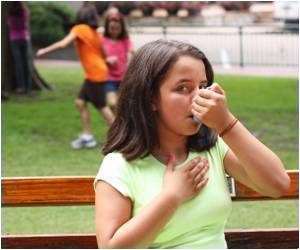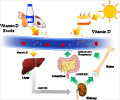People with high levels of vitamin D are better able to control their asthma. Vitamin D, also called the sunshine vitamin, is formed in the skin mainly when exposed to sunlight. It can also be obtained from the diet as well as through supplementation.
Vitamin D is converted to 25-Hydroxyvitamin D (25(OH)D) in the liver. Earlier studies have shown that vitamin D supplementation in children with asthma improves asthma control and suggested that increasing 25(OH)D levels could hold promise for future asthma health interventions.The question now is, does outdoor exposure, that is, exposure to sunlight influence the vitamin D levels in children with asthma, and if so, then how much exposure is required?
To find out, Sonali Bose and her colleagues at the Johns Hopkins University, Baltimore, studied 121 asthmatic children aged 2 to 6 years. The children were from the part in Baltimore with predominantly African-American people. The high prevalence of asthma in the region is suspected to be due to air pollutants and unique allergens, lower socio-economic status, and poor diet.
Serum 25(OH)D levels over a 6-month period were studied. Blood samples were evenly split across the seasons – summer, fall, winter, spring. Serum IgE levels, which are indicative of allergy, were also measured.
The findings were-
• 54 percent of the children were found to be insufficient or deficient, with levels below the accepted sufficient level of 30 ng/mL, and 23 percent of them were in the deficient range with serum levels of 20 ng/mL or below.
• Vitamin D levels for the small number of whites tended to be higher despite equivalent socio-economic status.
• Interestingly though, children who spent more than 5 hours per day outside were not 25-OH D deficient.
• There was no observed difference in 25(OH)D levels among the seasons, though according to the National Institutes of Health (NIH) data, low vitamin D levels are more common in African-American children, especially in the winter.
• There was an inverse correlation between 25-OH D levels and total IgE concentrations (immunoglobin that plays an important role in manifestation of asthma and other allergic diseases).
‘The implications of these findings may be even greater in younger cohorts, as it is during early childhood when considerable lung growth is still occurring, and when the respiratory system may be particularly sensitive to nutritional and environmental signals that induce changes in lung function,’ report the researchers.
‘Although UV light is necessary for dermal vitamin D production, black urban children with asthma appear to be unresponsive to what little daily sunlight they do receive, as higher daily levels of outdoor exposure were not linked to higher 25(OH)D’ the researchers inferred, ‘so, cutaneous synthesis alone during limited out door exposure is not sufficient to raise serum levels effectively in black urban children’.
‘A combination of limitations in sunlight exposure and darker pigmentation may amplify the risk of vitamin D deficiency among black urban children, contributing to greater asthma morbidity than their white counterparts,’ they concluded, and suggested further trials to determine whether increasing serum levels can reduce asthma maybe with dietary supplementation.
Source-Medindia















